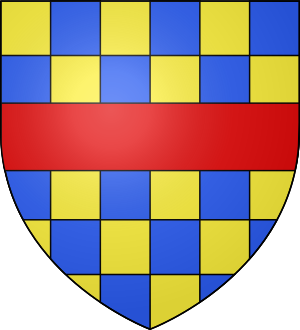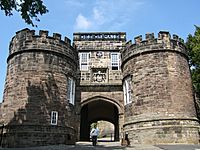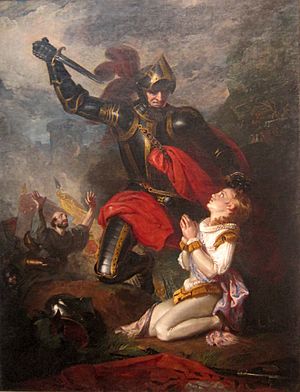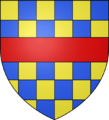John Clifford, 9th Baron Clifford facts for kids
Quick facts for kids John Clifford, 9th Baron de Clifford |
|
|---|---|
 |
|
| Arms of Clifford: Chequy or and azure, a fess gules | |
| Spouse(s) | Margaret Bromflete |
| Issue | |
| Henry Clifford, 10th Baron de Clifford Richard Clifford Elizabeth Aske |
|
| Noble family | Clifford |
| Father | Thomas Clifford, 8th Baron de Clifford |
| Mother | Joan Dacre |
| Born | 8 April 1435 |
| Died | 28 March 1461 (aged 25) Battle of Ferrybridge |
John Clifford, 9th Baron Clifford (born 8 April 1435 – died 28 March 1461) was an important military leader for the House of Lancaster during the Wars of the Roses in England. The Clifford family was one of the most powerful families in northern England during the 1400s. John Clifford became an orphan at age 20 when his father was killed in the first Battle of St Albans in 1455. This battle was the first major fight of the Wars of the Roses. Because of his father's death, John Clifford became a strong supporter of Margaret of Anjou, the wife of King Henry VI. She became the main leader of the Lancastrian side.
Contents
John Clifford's Early Life and Family

The Clifford family was known as one of the greatest families in the 1400s, even though they never became "earls." John Clifford was born on 8 April 1435, at Conisborough Castle. His father was Thomas Clifford, 8th Baron Clifford, and his mother was Joan Dacre.
John Clifford had three younger brothers and five sisters. His sister Elizabeth married Sir William Plumpton. Another sister, Maud, married Sir John Harrington. His youngest sisters were Joan and Margaret.
In 1454, John Clifford married Margaret Bromflete. She was the only daughter of Sir Henry Bromflete. John and Margaret had two sons and one daughter: Henry, who became the next Baron Clifford; a younger son named Richard; and a daughter named Elizabeth. Elizabeth later married Sir Robert Aske. Margaret Clifford lived longer than her husband and later married Sir Lancelot Threlkeld.
Early Career and Family Rivalries
John Clifford first became known on 24 August 1453. He supported his family's old friends, the House of Percy. At that time, the Percys were in a big fight, called a "feud," with their rivals in Yorkshire, the House of Neville. Clifford joined the Percy family in trying to ambush the wedding party of Thomas Neville. An ambush is a surprise attack.
John Clifford's life changed when his father was killed on 22 May 1455. His father was fighting against Richard, Duke of York and his Neville allies at the first Battle of St Albans. John Clifford was still too young to fully take over his family's lands. He officially received his inheritance on 16 June 1456. He was then made a Justice of the peace in Westmorland. He inherited the title of Baron de Clifford, the family home at Skipton Castle, and the important job of High Sheriff of Westmorland.
Many historians believe that his father's death made the fight with the Nevilles very personal for John Clifford. He wanted revenge for his father's death. In early 1458, King Henry VI tried to make peace between the fighting groups. He ordered everyone, including Clifford, to come to London. Clifford arrived with a large group of men and demanded payment for his father's death. He was with other young lords whose fathers had also been killed.
The king tried to settle things, and on 24 March, there was a special event called a 'Loveday'. This was a ceremony where the king tried to make peace between the warring families. As part of this peace, Clifford was supposed to be paid £666 by the Earl of Warwick. This money was to be shared among John and his brothers and sisters.
However, the king's efforts for peace did not last. Queen Margaret of Anjou, the king's wife, became more involved in politics and had more influence in the government. John Clifford became an important supporter of the Lancastrian side because he was young and energetic.
John Clifford and the Wars of the Roses
The civil wars started again in 1459. John Clifford was still on the side of King Henry and Queen Margaret. He attended a special meeting of parliament in November 1459. At this meeting, the Yorkists, who were now in exile, had their lands and titles taken away. This meeting was called the Parliament of Devils. Clifford swore loyalty to the new heir to the throne, Edward of Westminster, Prince of Wales.
Because the Yorkists lost their lands, the king gave some of them to people who had stayed loyal. Clifford was given the Honour of Penrith and Penrith Castle. These lands had belonged to the Earl of Salisbury, a Neville. These lands were close to Clifford's own family estates. In April 1460, he was made warden of the western marches, an important job defending the border with Scotland. This job had traditionally belonged to the Nevilles.
In June 1460, the Yorkists returned to England. On 10 July, they defeated the royal army at the Battle of Northampton and captured the king. After this, Clifford was ordered to give Penrith Castle back to the Earl of Salisbury. But Clifford did not obey. He and other Lancastrian lords in the north kept control of most of the region.
In October 1460, the Duke of York claimed the throne. A parliament was called to discuss this. They decided that the Prince of Wales would not inherit the throne, and instead, York and his heirs would. This decision made Clifford and his friends even stronger supporters of the Queen. Clifford probably met with Queen Margaret in Kingston upon Hull. There, she was gathering Lancastrian lords and their followers. Soon, they had an army of thousands.
Clifford and other lords were accused of destroying the lands and homes of York and Salisbury in Yorkshire. To stop these attacks, York and Salisbury led an army north. On 30 December 1460, the two armies met at the Battle of Wakefield. Clifford commanded one part of the Lancastrian army. The Yorkist army was completely defeated. Both York and Salisbury were killed. Before the battle, Clifford was made a knight by the Lancastrian commander, Henry Beaufort, Duke of Somerset.
The Death of the Earl of Rutland
One famous story from the Battle of Wakefield is about Clifford killing Edmund, Earl of Rutland. Rutland was the 17-year-old son of the Duke of York and the younger brother of the future King Edward IV. This event may have led to Clifford being called 'Butcher Clifford'. However, historians disagree on how widely this nickname was used at the time.
Some early writers said that Clifford killed Rutland on Wakefield Bridge while Rutland was trying to escape. Later stories, like those in Shakespeare's play Henry VI, Part 3, added details that were not true. For example, they said Rutland was only 12 years old, not 17. They also claimed Clifford beheaded the Duke of York, but the Duke most likely died during the fighting. Many historians say that most of the later descriptions of Clifford at Wakefield are not very accurate because they were written much later.
John Clifford's Death and Legacy
After the victory at Wakefield, Clifford and other Lancastrian lords went south with Queen Margaret's army. On 17 February 1461, they fought a Yorkist army at St Albans. The Lancastrians won again, and King Henry VI was rescued from Warwick and reunited with his wife and son.
However, instead of marching on London, the royal army went back north. Clifford went with them. The Yorkist army, now led by Edward of York and Richard, Earl of Warwick, followed them. On 28 March 1461, parts of the two armies clashed while trying to cross the River Aire at Ferrybridge. This fight is now called the Battle of Ferrybridge. Clifford's Lancastrian force captured the bridge. But the Yorkists crossed the river further upstream and attacked Clifford's men from the side.
John Clifford was killed at Ferrybridge, possibly by an arrow to the throat. He was buried in a common grave with others who died in that fight. The main Lancastrian army was only a few miles away but did not come to help him.
The day after Clifford's death, the main Yorkist and Lancastrian armies fought at the Battle of Towton. This was one of the biggest and bloodiest battles ever in England. The Lancastrians were completely defeated. The Duke of York's son was crowned King Edward IV.
On 4 November 1461, King Edward IV declared Clifford a "traitor" and took away all his lands and titles. A large part of these lands was later given to the Earl of Warwick. There is a story that Clifford's wife, fearing her son Henry would be killed in revenge for Rutland's death, sent him into hiding as a shepherd. However, historians believe this story is likely a legend. Henry Clifford was pardoned in 1472, and he was publicly mentioned receiving a gift as early as 1466. Still, he might have hidden for a short time from his father's enemies.
Fictional Stories and Reputation
In Shakespeare's play Henry VI, Part 3, John Clifford is shown killing the young Edmund, Earl of Rutland after the Battle of Wakefield. However, later historical sources say that Rutland was killed during the battle itself, not afterwards.
Clifford is also a character in Sharon Kay Penman's historical novel, The Sunne in Splendour.
Images for kids
-
Skipton Castle, the home of the Clifford family.





